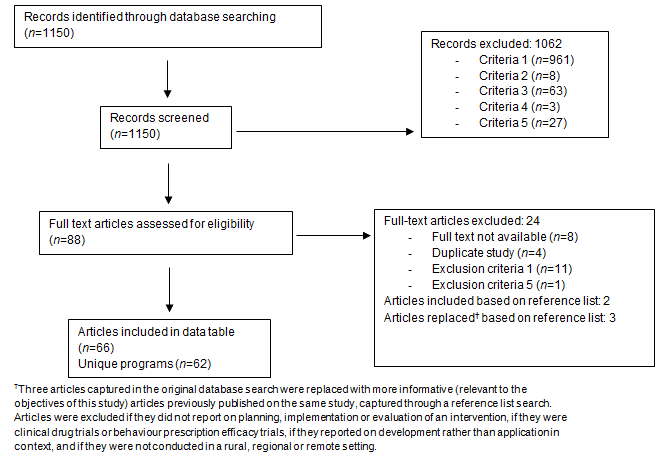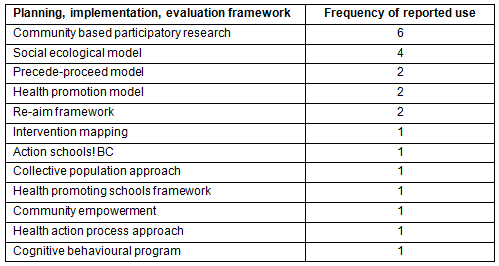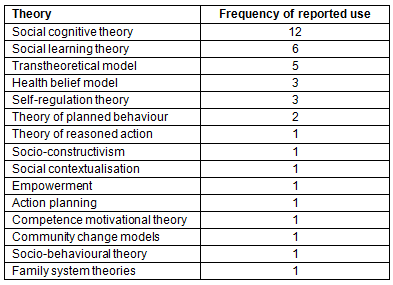In Australia, cardiometabolic risk factors (CMRs) and cardiometabolic diseases (CMDs) are in excess in rural and remote communities, which can be disadvantaged by reduced access to primary and secondary health services1 and other conditions of 'place' that drive the expression of risk factors in individuals, termed 'environmental risk conditions'2,3. Together, the poorer access to health services and the population risk conferred by factors that are not amenable to change by 'treating the individual' using traditional health services makes high-quality community health promotion paramount for the management of population health risk in these settings.
The most prevalent CMD, type 2 diabetes mellitus, and its common causal risk factor abdominal obesity are endemic in the developed world and rising to epidemic levels across the developing world. Current evidence suggests that abdominal obesity constitutes the major clinical risk factor for the development of CMDs, with population attributable risks of 47% (for type 2 diabetes) and 13% (for cardiovascular disease) in Australia4.
Producing positive behavioural change to reduce this major causal risk factor requires targeting health behaviour at multiple levels, such as individual, organisational and community (as well as political). Thus, health promotion programs built upon a solid understanding of health behaviours and the socio-environmental contexts in which they occur have been found to be the most successful5.
The quality of applied health promotion research and practice varies, and the failure of low-quality programs has been associated with four major factors: (1) poorly specified or poorly rationalised intervention strategies6; (2) atheoretical approaches or theory failure5; (3) implementation failure6; and (4) weak evaluation7.
The impact of these factors may be minimised by the use of comprehensive frameworks, which enables strategic planning and implementation of interventions, which can be further improved through evaluation. The content and structure of these frameworks are largely based on the guiding principles in which initiatives should be empowering, participatory, holistic, intersectoral, equitable, sustainable, and multistrategy - features that have evolved throughout the modern history of health promotion8. Furthermore, a sound theoretical basis underpinning the design of intervention strategies has been shown to increase the ultimate likelihood of success of health promotion programs, with increasing evidence suggesting larger effects with the use of multiple theories5.
This study aims to examine the extent to which health promotion programs focusing on modifying CMR or CMD in rural and remote settings report the use of health promotion planning, implementation and evaluation frameworks and pertinent socio-behavioural theories.
A search of the literature indexed in PubMed, ScienceDirect, the Cochrane Library and EBSCOHost was performed, backwards from December 2013 with no limit for maximal comprehensiveness. The search was limited to English language. The search strategy, as follows, was developed in order to achieve the stated research objective.
First, search terms for frameworks or theories were not specifically included as this would bias the results towards papers that report such use. Rather, health promotion programs were first searched for using the following terms: '(community intervention OR complex intervention OR community-based participatory research OR health promotion program)'.
Second, for CMR- and CMD-focused health promotion programs, behavioural and environmental intervention strategies are critical, so to reduce the possibility of missing pertinent studies in the above search, a search line was also included based on behavioural and environmental interventions using the following terms: '(behavioral risk factor* OR lifestyle OR environment*)'.
Third, a geographical setting focus was taken on rural and remote populations. Definitions of rural, remote and regional differ from country to country so all three terms were included: '(rural OR regional OR remote)'. Other terms such as 'agricultural populations', 'isolated populations'; 'indigenous populations' could also have been included; however, the latter two are not necessarily confined to rural and remote geographies.
Last, health promotion programs that target the prevention and management of CMD and reduction of CMR in the population were focused on. Common terms in this literature include obesity, metabolic syndrome, type 2 diabetes and cardiovascular diseases so the following search terms were included: '(obesity OR type 2 diabetes OR metabolic syndrome OR cardiometabolic risk OR cardiovascular disease risk)'. All studies identified by the search were assessed for relevance on the basis of a screen of the title and abstract, and, further to the search criteria, articles were eligible for inclusion if they reported on the planning and/or implementation and/or evaluation of intervention strategies. Exclusion criteria were also applied and included: (1) the study does not report on planning, implementation or evaluation of an intervention; (2) clinical drug trials such as these are not within the scope of community health promotion; (3) behaviour prescription efficacy trials such as these are not within the scope of the application of health promotion strategies in real-world contexts; (4) reports only on the development of a framework or theory (rather than on its application in context) and (5) not in a rural, regional or remote setting.
The full text of the selected articles was then accessed and reassessed for final inclusion, with additional relevant articles being selected using the reference lists of the included articles. A flowchart of the study selection is presented in Figure 1. Data extraction was then performed using a standardised form, which was piloted on the first ten articles and then adjusted accordingly. Data were collected on the study aim and conclusion; sample size and participant criteria; study design/methods; comparison/control groups; planning, implementation and evaluation framework used; theoretical constructs integrated; and process, impact and outcome evaluation. These data are synthesised in Table 1 (supplementary). A second author, who was blinded to the results of the first author, assessed approximately 15% of articles identified from abstracts and performed inclusion/exclusion screening and data extraction as aforementioned. This was in order to validate the results of the first author, and due to the high consistency during the literature screening and data extraction process, examining the remaining 85% of articles was unnecessary.

Figure 1: Flowchart of search results and the application of inclusion and exclusion criteria and reference list searching.
Table 1 (supplementary): A summary of the key data extracted from the 62 unique programs (66 unique journal articles) regarding the quality of applied health promotion programs targeting cardiometabolic disease risk in rural and remote populations. The key elements of quality examined were the explicit reporting of a planning, implementation and evaluation framework(s); and explicit reporting of the integration of appropriate behavioural theories/theoretical constructs into the development of intervention strategies9-74

Click on thumbnail to view Table 1
Figure 1 represents the results of the database search, the application of inclusion and exclusion criteria, and additional inclusions based on reference list searches. A total of 1150 unique articles were identified by the initial search, and of these, 88 articles were eligible for study inclusion after applying the exclusion criteria based on title and abstract alone. Except for eight articles, the full text was retrieved and following further assessment, a total of 66 articles were included in Table 1, with 62 different programs being reported.
Of the 62 programs summarised (Table 1), 23 used a planning, implementation and evaluation framework (37%). The frequency of the reported frameworks is shown in Table 2, with the community based participatory research and social ecological model being the most frequently reported, respectively. Of the 62 programs, 22 explicitly reported the adoption of appropriate whole theories or theoretical constructs (35%). The frequency of reported theories is shown in Table 3, with social cognitive theory and its predecessor social learning theory being the most frequently reported, followed by the transtheoretical model. In total, 32 programs (52%) reported using one or other of a framework (for planning, implementation and evaluation) or pertinent theories to underpin intervention strategies. Within these, ten programs (16%) reported use of both.
The frequency of both reported framework and theory use varied to a small degree across different health promotion settings. Table 4 shows the frequency of reporting of both frameworks and theories across the settings of primary care, whole-of-community and community organisations (including schools and workplaces). The greater frequency of reported use of both frameworks and theories occurred in the community organisation settings.
Each program that had progressed to implementation as reported in the articles included an impact and outcome evaluation (n=52), and of these, nine explicitly reported an impact evaluation (17%), and 14 an outcome evaluation (27%). Twenty-four programs included a process evaluation (46%), 18 of which explicitly reported such (75%).
Table 2: Proportion of planning, implementation and evaluation frameworks used in health promotion programs targeting cardiometabolic disease risk in rural and remote places

Table 3: Proportions of whole theories or specific constructs used in health promotion programs targeting cardiometabolic disease risk in rural and remote places

Table 4: A summary of the explicit reporting of the use of health promotion frameworks and theories by health promotion setting, from the 62 unique programs covered in the 66 reviewed articles

Discussion
The most successful health promotion interventions are those designed with a structured framework for the ongoing development and maintenance of the program, and which enable continuous improvement through evaluation75. These frameworks embody the cardinal principles of health promotion, by increasing community capacity and empowering individuals, creating supportive environments, encouraging participation, taking a broad view of health and fostering intersectoral collaboration8. Furthermore, those designed with an explicit theoretical foundation are more effective at improving health behaviour5. Despite this, the development and implementation of health-promotion intervention strategies often proceeds without the use of these evidence-based approaches76.
This review has demonstrated, in the context of health promotion programs targeting the reduction of CMD risk in rural and remote populations, that 16% reported using both a standardised framework and pertinent theoretical constructs to underpin intervention strategy development and implementation. Moreover, 50% of programs did not incorporate either a framework or a theoretical foundation, strongly suggesting that the quality and rigour of applied health promotion programs targeting the reduction of CMD risk in rural and remote populations can be strengthened.
These findings tended to vary by the nature of the health promotion setting in rural and remote communities with community organisational interventions (including school and workplace-based programs) more frequently reporting the use of frameworks and theories when compared with 'whole-of-community' or primary care based programs.
In the 37% of programs that reported using a planning, implementation and evaluation framework, the most frequently used were community-based participatory research (CBPR) (26%) and social ecological model (SEM) (17%). However, there were ten alternative frameworks or models that were adopted and reported in this literature. CBPR is a transformative research model, which encourages community involvement and social action, facilitating health-oriented interactions and cohesiveness between academics, health professionals and the community. This enables interventions to be implemented across a larger population, and through integrating community theories into the research, this increases the likelihood of an intervention being long-lasting and successful76.
SEM was translated to a set of guidelines for community health promotion in 199677. It positions behaviour as the outcome of interest, being determined by public policy, community factors, institutional factors, interpersonal processes and primary groups, and intrapersonal factors. This model targets both social environmental factors and the individual for health promotion, with interventions aimed at changing intrapersonal, interpersonal, institutional, community and global parameters78.
Both of these models have much in common with the precede-proceed model, which is perhaps the most comprehensive, integrated and well-known health promotion model, composed of formative phases (Precede: social, epidemiological, behavioural, environmental, educational and organisational diagnoses; resources and support appraisal), followed organically by implementation (representing the transition to Proceed) and evaluation of process (theory function), impact (on behavioural goals) and outcomes (on health and quality of life goals)15,79.
Of the adopted and explicitly reported theories in 35% of programs, social cognitive theory (SCT) and its predecessor social learning theory together accounted for close to half of all reported use across these health promotion programs (45%). However, more than a dozen other theories were adopted by the remainder of programs. SCT conceptualises human behaviour as the result of continuous reciprocal interaction between cognitive, behavioural and environmental factors; observation, imitation, and modelling of others' behaviours drives the individual's behaviour, which is subsequently either reinforced or deterred by reward or punishment, respectively. SCT describes four steps through which the individual must proceed: attention, retention, reproduction and motivation80.
The reasons for the choices of frameworks and theories adopted for these health promotion programs in these settings was in most cases not well articulated, although common to most frameworks was the principle that adopted theories should have meaning in the community setting and reflect the communities' understanding of CMD causation, prevention and management. This study has examined the extent of use, and has added to the literature knowledge about the frequency rank of framework and theory use for cardiometabolic health promotion in underserved rural and remote settings. However, future work should seek to better understand the reasons behind the adoption of specific frameworks and theories in health promotion programs across different community settings and target populations.
The possible impact of publication bias needs to be considered in the extrapolation of these findings beyond health promotion programs that are published in the academic literature. Many health promotion programs may have occurred in rural and remote settings that were never published and this review provides no knowledge of whether they were conducted under common frameworks or whether pertinent socio-behavioural theories were adopted in the development of intervention strategies. A limitation of this review is that a single author performed all the inclusion and exclusion criteria assessments and data extraction from full texts. Validation of inclusion/exclusion screening and data extraction was performed by a second author on approximately 15% of articles. Future research in this area could include investigating the interaction between the effectiveness and the quality of these programs in terms of their conceptual foundation.
Analysis of published literature indicates that 35% of health promotion programs targeting CMD risk in rural and remote settings reported using a planning, implementation and evaluation framework, and 35% reported a theoretical basis for intervention strategies. With approximately 20% overlap of programs reporting the use of both, this means half of the studies reviewed did not report using either a framework or theoretical basis for intervention. The most successful health promotion interventions are those that are based on these fundamental principles. Therefore, this review highlights the considerable remaining scope for improvement in the quality of conduct and reporting of health promotion programs targeting CMD risk in rural settings.
The combination of high prevalence of CMD and relatively poor access to primary healthcare services in rural and remote populations in Australia contributes to excess morbidity and mortality. In these settings, the use of best practice community health promotion programs is of increasing importance in order to optimise the ability of the discipline to achieve population health improvements in these disadvantaged populations.
Acknowledgements
SI and AS were supported by vacation research bursaries from the UniSA Department of Rural Health and stipends from an NHMRC program grant (#631947). DKP was supported by a PhD scholarship through the University Department of Rural Health (Australian Government Department of Health and Ageing). MTH was supported by a University of South Australia-Royal Flying Doctor Service Fellowship.
References
1. Carey TA, Wakerman J, Humphreys JS, Buykx P, Lindeman M. What primary health care services should residents of rural and remote Australia be able to access? A systematic review of 'core' primary health care services. BMC Health Services Research 2013; 13(178): 1472-6963.
2. Daniel M, Moore S, Kestens Y. Framing the biosocial pathways underlying associations between place and cardiometabolic disease. Health and Place 2008; 14(2): 117-132.
3. Daniel M, Lekkas P, Cargo M, Stankov I, Brown A. Environmental risk conditions and pathways to cardiometabolic diseases in indigenous populations. Annual Reviews of Public Health 2011; 32: 327-347.
4. Cameron AJ, Dunstan DW, Owen N, Zimmet PZ, Barr EL, Tonkin AM, et al. Health and mortality consequences of abdominal obesity: evidence from the AusDiab study. Medical Journal of Australia 2009; 191(4): 202-208.
5. Glanz K, Bishop DB. The role of behavioral science theory in development and implementation of public health interventions. Annual Review of Public Health 2010; 31: 399-418.
6. Proctor E, Silmere H, Raghavan R, Hovmand P, Aarons G, Bunger A, et al. Outcomes for implementation research: conceptual distinctions, measurement challenges, and research agenda. Administration and Policy in Mental Health 2011; 38(2): 65-76.
7. Ni Mhurchu C, Aston LM, Jebb SA. Effects of worksite health promotion interventions on employee diets: a systematic review. BMC Public Health 2010; 10: 62.
8. World Health Organisation. Evaluation in health promotion: principles and perspectives. WHO Regional Publications European Series, No. 92; 2001.
9. Adams AK, LaRowe TL, Cronin KA, Prince RJ, Wubben DP, Parker T et al. The Healthy Children, Strong Families intervention: design and community participation. Journal of Primary Prevention 2012; 33(4): 175-185.
10. Balagopal P, Kamalamma N, Patel TG, Misra R. A community-based participatory diabetes prevention and management intervention in rural India using community health workers. Diabetes Educator 2012; 38(2): 822-834
11. Ho LS, Gittelsohn J, Harris SB, Ford E. Development of an integrated diabetes prevention program with First Nations in Canada. Health Promotion International 2006; 21(2): 88-97.
12. Zimmermann K, Khare MM, Huber R, Moehring PA, Koch A, Geller SE. Southern Seven Women's Initiative for Cardiovascular Health: lessons learned in community health outreach with rural women. American Journal of Health Education 2012; 43(6): 349-355.
13. Yeary KH, Cornell CE, Turner J, Moore P, Bursac Z, Prewitt TE et al. Feasibility of an evidence-based weight loss intervention for a faith-based, rural, African American population. Preventing Chronic Disease 2011; 8(6): A146.
14. Bazzano AT, Zeldin AS, Shihady Diab IR, Garro NM, Allevato NA, Lehrer D. The Healthy Lifestyle Change Program: a pilot of a community-based health promotion intervention for adults with developmental disabilities. American Journal of Preventive Medicine 2009; 37(6 Suppl 1): S201-S208.
15. de Silva-Sanigorski AM, Bell AC, Kremer P, Nichols M, Crellin M, Smith M et al. Reducing obesity in early childhood: results from Romp & Chomp, an Australian community-wide intervention program. American Journal of Clinical Nutrition 2010; 91(4): 831-840.
16. Puder JJ, Marques-Vidal P, Schindler C, Zahner L, Niederer I, Burgi F et al. Effect of multidimensional lifestyle intervention on fitness and adiposity in predominantly migrant preschool children (Ballabeina): cluster randomised controlled trial. British Medical Journal 2011; 343: 6195.
17. Niederer I, Kriemler S, Zahner L, Burgi F, Ebenegger V, Hartmann T et al. Influence of a lifestyle intervention in preschool children on physiological and psychological parameters (Ballabeina): study design of a cluster randomized controlled trial. BMC Public Health 2009; 9: 94.
18. Prabhakaran D, Jeemon P, Goenka R, Lakshmy K, Thankappan KR, Ahmed F et al. Impact of a worksite intervention program on cardiovascular risk factors: a demonstration project in an Indian industrial population. Journal of the American College of Cardiology 2009; 53(18): 1718-1728.
19. Duffany KO, Mckee M, Woodward M, Finegood DT, Yach D, Stevens D et al. Community Interventions for Health (CIH): a novel approach to tackling the worldwide epidemic of chronic diseases. CVD Prevention and Control 2011; 6(2): 47-56.
20. Greening L, Harrell TK, Low AK, Fielder CE. Efficacy of a school-based childhood obesity intervention program in a rural southern community: TEAM Mississippi Project. Obesity 2011; 19(6): 1213-1219.
21. Draper CE, de Villiers A, Lambert EV, Fourie J, Hill J, Dalais L et al. HealthKick: a nutrition and physical activity intervention for primary schools in low-income settings. BMC Public Health 2010; 10: 398.
22. Williamson DA, Champagne CM, Harsha D, Han H, Martin CK, Newton Jr RL et al. Louisiana (LA) Health: design and methods for a childhood obesity prevention program in rural schools. Contemporary Clinical Trials 2008; 29(5): 783-795.
23. Williamson DA, Champagne CM, Harsha DW, Han H, Martin CK, Newton RLJ et al. Effect of an environmental school-based obesity prevention program on changes in body fat and body weight: a randomized trial. Obesity (Silver Spring) 2012; 20(8): 1653-1661.
24. Newton RL, Thomson JL, Rau K, Duhe S, Sample A, Singleton H et al. Psychometric characteristics of process evaluation measures for a rural school-based childhood obesity prevention study: Louisiana Health. American Journal of Health Promotion 2011; 25(6): 417-421.
25. Carr LJ, Bartee RT, Dorozynski C, Broomfiled JF, Smith ML, Smith DT. Internet-delivered behavior change program increases physical activity and improves cardiometabolic disease risk factors in sedentary adults: results of a randomized controlled trial. Preventive Medicine 2008; 46(5): 431-438.
26. Parra-Medina D, Wilcox S, Wilson DK, Addy CL, Felton G, Poston MB. Heart Healthy and Ethnically Relevant (HHER) Lifestyle trial for improving diet and physical activity in underserved African American women. Contemporary Clinical Trials 2010; 31(1): 92-104.
27. Winett RA, Anderson ES, Whiteley JA, Wojcik JR, Rovniak LS, Graves KD et al. Church-based health behavior programs: using social cognitive theory to formulate interventions for at-risk populations. Applied and Preventive Psychology 1999; 8(2): 129-142.
28. Von Gruenigen VE, Courneya KS, Gibbons HE, Kavanagh MB, Waggoner SE, Lerner E. Feasibility and effectiveness of a lifestyle intervention program in obese endometrial cancer patients: a randomized trial. Gynecologic Oncology 2008; 109(1): 19-26.
29. Simmons D, Rush E, Crook N, Te Wai o Rona: Diabetes Prevention Strategy Team. Development and piloting of a community health worker-based intervention for the prevention of diabetes among New Zealand Maori in Te Wai o Rona: Diabetes Prevention Strategy. Public Health Nutrition 2008; 11(12): 1318-1325.
30. Kilkkinen A, Heistaro S, Laatikainen T, Janus E, Chapman A, Absetz P et al. Prevention of type 2 diabetes in a primary health care setting. Interim results from the Greater Green Triangle (GGT) Diabetes Prevention Project. Diabetes Research and Clinical Practice 2007; 76(3): 460-462.
31. Daniel M, Green LW, Mario SA, Gamble D, Herbert CP, Hertzman C et al. Effectiveness of community-directed diabetes prevention and control in a rural Aboriginal population in British Columbia, Canada. Social Science and Medicine 1999; 48(6): 815-832.
32. Hageman PA, Pullen CH, Hertzog M, Boeckner LS, Walker SN. Web-based interventions for weight loss and weight maintenance among rural midlife and older women: protocol for a randomized controlled trial. BMC Public Health 2011; 11: 521.
33. Balagopal P, Kamalamma N, Patel TG, Misra R. A community-based diabetes prevention and management education program in a rural village in India. Diabetes Care 2008; 31(6): 1097-1104.
34. Riddell MA, Renwick A, Wolfe R, Colgan S, Dunbar J, Hagger V et al. Cluster randomized controlled trial of a peer support program for people with diabetes: study protocol for the Australasian Peers for Progress study. BMC Public Health 2012; 12: 843-853.
35. Rowley KG, Daniel M, Skinner K, Skinner M, White GA, O'Dean K et al. Effectiveness of a community-directed 'healthy lifestyle' program in a remote Australian aboriginal community. Australian & New Zealand Journal of Public Health 2000; 24(2): 136-144.
36. Wapner A. Bianco JA, Long M, Kushnick MR, Brannan G, Shubrook. TAKE ACTION: a multidisciplinary lifestyle intervention for families in a rural community. Childhood Obesity 2010; 6(5): 270-276.
37. Debussche X, Collin F, Fianu A, Balcou-Debussche M, Fouet-Rosiers I, Koleck M et al. Structured self-management education maintained over two years in insufficiently controlled type 2 diabetes patients: the ERMIES randomised trial in Reunion Island. Cardiovascular Diabetology 2012; 11: 91.
38. Huang S, Hu X, Chen H, Xie D, Gan X, Wu Y et al. The positive effect of an intervention program on the hypertension knowledge and lifestyles of rural residents over the age of 35 years in an area of China. Hypertension Research 2011; 34(4): 503-508.
39. Janicke DM, Lim CS, Perri MG, Mathews A, Bobroff L, Silverstein JH et al. The Extension Family Lifestyle Intervention Project (E-FLIP for Kids): design and methods. Contemporary Clinical Trials 2011; 32(1): 50-58.
40. Johnson LT, Ralston PA, Jones E. Beauty salon health intervention increases fruit and vegetable consumption in African-American women. Journal of the American Dietetic Association 2010; 110(6): 941-945.
41. Adams J, Molyneux M, Squires L. Sustaining an obesity prevention intervention in preschools. Health Promotion Journal of Australia 2011; 22(1): 6-10.
42. Adams J, Zask A, Dietrich U. Tooty Fruity Vegie in preschools: an obesity prevention intervention in preschools targeting children's movement skills and eating behaviours. Health Promotion Journal of Australia 2009; 20(2): 112-119.
43. Naylor P, Scott J, Drummond J, Bridgewater L, McKay HA, Panagiotopoulos C. Implementing a whole school physical activity and healthy eating model in rural and remote First Nations schools: a process evaluation of Action Schools! BC. Rural and Remote Health 10(2): 1296. (Online) 2010. Available: www.rrh.org.au (Accessed 15 March 2013).
44. Nguyen QN, Pham ST, Nguyen VL, Weinehall L, Wall S, Bonita R et al. Effectiveness of community-based comprehensive healthy lifestyle promotion on cardiovascular disease risk factors in a rural Vietnamese population: a quasi-experimental study. BMC Cardiovascular Disorders 2012; 12: 56.
45. Parker VG, Coles C, Logan BN, Davis L. The LIFE project: a community-based weight loss intervention program for rural African American women. Family and Community Health 2010; 33(2): 133-143.
46. Qiao Q, Pang Z, Gao W, Wang S, Dong Y, Zhang L et al. A large-scale diabetes prevention program in real-life settings in Qingdao of China (2006-2012). Primary Care Diabetes 2010; 4(2): 99-103.
47. Reinhardt JA, van der Ploeg HP, Grzegrzulka R, Timperley JG. Implementing lifestyle change through phone-based motivational interviewing in rural-based women with previous gestational diabetes mellitus. Health Promotion Journal of Australia 2012; 23(1): 5-9.
48. Sarrafzadegan N, Kelishadi R, Esmailzadeh A, Mohammadifard N, Rabiei K, Roohafza H et al. Do lifestyle interventions work in developing countries? Findings from the Isfahan Healthy Heart Program in the Islamic Republic of Iran. Bulletin of the World Health Organisation 2009; 87(1): 39-50.
49. Vadheim LM, Brewer KA, Kassner DR, Vanderwood KK, Hall TO, Butcher MK et al. Effectiveness of a lifestyle intervention program among persons at high risk for cardiovascular disease and diabetes in a rural community. Journal of Rural Health 2010; 26(3): 266-272.
50. Vadheim LM, McPherson C, Kassner DR, Vanderwood KK, Hall TO, Butcher MK. et al. Adapted diabetes prevention program lifestyle intervention can be effectively delivered through telehealth. Diabetes Educator 2010; 6(4): 651-656.
51. Ackermann RT, Finch EA, Brizendine E, Zhou H, Marrero DG. Translating the Diabetes Prevention Program into the community. The DEPLOY Pilot Study. American Journal of Preventive Medicine 2008; 35(4): 357-363.
52. Stock S, Miranda C, Evans S, Plessis S, Ridley J, Yeh S et al. Healthy Buddies: a novel, peer-led health promotion program for the prevention of obesity and eating disorders in children in elementary school. Pediatrics 2007; 120(4): e1059-1068.
53. Dalton WT 3rd, Schetzina KE, Holt N, Fulton-Robinson H, Ho AL, Tudiver F et al. Parent-Led Activity and Nutrition (PLAN) for healthy living: design and methods. Contemporary Clinical Trials 2011; 32(6): 882-892.
54. Janicke DM, Lim CS, Mathews AE, Shelnutt KP, Boggs SR, Silverstein JH et al. The community-based healthy-lifestyle intervention for rural preschools (CHIRP) study: design and methods. Contemporary Clinical Trials 2013; 34(2): 187-195.
55. Janicke DM, Sallinen BJ, Perri MG, Lutes LD, Silverstein JH, Huerta MG et al. Sensible treatment of obesity in rural youth (STORY): design and methods. Contemporary Clinical Trials 2008; 29(2): 270-280.
56. Pettman TL, Buckley JD, Misan GM, Coates AM, Howe PR. Health benefits of a 4-month group-based diet and lifestyle modification program for individuals with metabolic syndrome. Obesity Research and Clinical Practice 2009; 3(2): 221-235.
57. Samuel-Hodge CD, Garcia BA, Johnston LF, Kraschnewski JL, Gustafson AA, Norwood AF et al. Rationale, design, and sample characteristics of a practical randomized trial to assess a weight loss intervention for low-income women: the Weight-Wise II Program. Contemporary Clinical Trials 2012; 33(1): 93-103.
58. Robinson-Whelen S, Hughes RB, Taylor HB, Colvard M, Mastel-Smith, Nosek MA. Improving the health and health behaviors of women aging with physical disabilities: a peer-led health promotion program. Womens Health Issues 2006; 16(6): 334-345.
59. Vogt R, Bersamin A, Ellemberg C, Winkleby MA. Evaluation of risk factors and a community intervention to increase control and treatment of asthma in a low-income semi-rural California community. Journal of Asthma 2008; 45(7): 568-574.
60. Taylor RW, Mcauley KA, Williams SM, Barbezat W, Nielsen G, Mann JI. Reducing weight gain in children through enhancing physical activity and nutrition: the APPLE project. International Journal of Pediatric Obesity 2006; 1(3): 146-152.
61. Gracey M, Bridge E, Martin D, Jones T, Spargo RM, Shephard M et al. An Aboriginal-driven program to prevent, control and manage nutrition-related 'lifestyle' diseases including diabetes. Asia Pacific Journal of Clinical Nutrition 2006; 15(2): 178-188.
62. Amundson HA, Butcher MK, Gohdes D, Hall TO, Harwell TS, Helgerson SD et al. Translating the diabetes prevention program into practice in the general community: findings from the Montana Cardiovascular Disease and Diabetes Prevention Program. Diabetes Educator 2009; 35(2): 209-223.
63. Williams A, Wold J, Dunkin J, Idleman L, Jackson C. CVD prevention strategies with urban and rural African American women. Applied Nursing Research 2004; 17(3): 187-194.
64. Ronda G, Van Assema P, Candel M, Ruland E, Steenbakkers M, Van Ree J et al. The Dutch Heart Health community intervention 'Hartslag Limburg': results of an effect study at individual level. Health Promotion International 2004; 19(1): 21-31.
65. Aoun S, Rosenberg M. Are rural people getting HeartSmart? Australian Journal of Rural Health 2004; 12(2): 81-88.
66. Lupton BS, Fonnebo V, Sogaard AJ. The Finnmark Intervention Study: is it possible to change CVD risk factors by community-based intervention in an Arctic village in crisis? Scandinavian Journal of Public Health 2003; 31(3): 178-186.
67. Mayer-Davis EJ, D'Antonio AM, Smith SM, Kirkner G, Levin Martin S, Parra-Medina D et al. Pounds off with empowerment (POWER): a clinical trial of weight management strategies for black and white adults with diabetes who live in medically underserved rural communities. American Journal of Public Health 2004; 94(10): 1736-1742.
68. Rowley KG, Daniel M, Skinner K, Skinner M, White GA, O'Dea K. Effectiveness of a community-directed 'healthy lifestyle' program in a remote Australian aboriginal community. Australian New Zealand Journal of Public Health 2000; 24(2): 136-144.
69. Weinehall L, Westman G, Hellsten G, Boman K, Hallmans G, Pearson TA et al. Shifting the distribution of risk: results of a community intervention in a Swedish programme for the prevention of cardiovascular disease. Journal of Epidemiology and Community Health 1999; 53(4): 243-250.
70. Gibbins RL, Riley M, Brimble P. Effectiveness of programme for reducing cardiovascular risk for men in one general practice. British Medical Journal 1993; 306(6893): 1652-1656.
71. Lakerveld J, Bot SD, Chinapaw MJ, van Tulder MW, van Oppen P, Dekker et al. Primary prevention of diabetes mellitus type 2 and cardiovascular diseases using a cognitive behavior program aimed at lifestyle changes in people at risk: Design of a randomized controlled trial. BMC Endocrine Disorders 2008; 8: 6.
72. Chow CK, Joshi R, Gottumukkala AK, Raju K, Raju R, Reddy S et al. Rationale and design of the Rural Andhra Pradesh Cardiovascular Prevention Study (RAPCAPS): a factorial, cluster-randomized trial of 2 practical cardiovascular disease prevention strategies developed for rural Andhra Pradesh, India. American Heart Journal 2009; 158(3): 349-355.
73. Harrell TK, Davy BM, Stewart JL, King DS. Effectiveness of a school-based intervention to increase health knowledge of cardiovascular disease risk factors among rural Mississippi middle school children. Southern Medical Journal 2005; 98(12): 1173-1180.
74. Perri MG, Limacher MC, Durning PE, Janicke DM, Lutes LD, Bobroff LB et al. Extended-care programs for weight management in rural communities: the treatment of obesity in underserved rural settings (TOURS) randomized trial. Archives of Internal Medicine 2008; 168(21): 2347-2354.
75. Green L, Kreuter M. Health program planning: an educational and ecological approach. 4th edn. New York: McGraw Hill, 2005.
76. Wallerstein N, Duran B. Community-based participatory research contributions to intervention research: the intersection of science and practice to improve health equity. American Journal of Public Health 2010; 1(100): 10.
77. Stokols D. Translating social ecological theory into guidelines for community health promotion. American Journal of Health Promotion 1996 Mar-Apr; 10(4): 282-298.
78. McLeroy KR, Bibeau D, Steckler A, Glanz K. An ecological perspective on health promotion programs. Health Education Quarterly 1988; 15(4): 351-377.
79. Phillips JL, Rolley JX, Davidson PM. Developing targeted health service interventions using the PRECEDE-PROCEED model: two Australian case studies. Nursing Research and Practice 2012; 2012: 279431.
80. Rosenstock IM, Strecher VJ, Becker MH. Social learning theory and the health belief model. Health Education Quarterly 1988; 15: 175-183.



